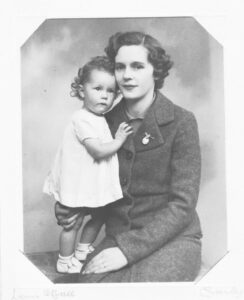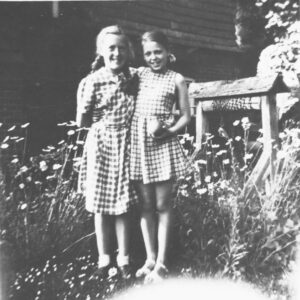
Rosemary as a child and her Mum, Dorothy Harris.
In May 1945, Crawley in common with towns and villages throughout the land, heard a new and wonderful sound. Older people heard it with disbelief and children were woken so that they might
hear it for the first time. It was the magical and joyous sound of Church bells ringing out their message of triumph and victory, after years of enforced silence.
Inhabitants of Crawley came out of their houses, hardly able to believe, even the wireless messages, that the war, at least in Europe was finished. Could the terror anxieties and weary treadmill of nearly 6 years of war, was really over?… Gradually fear receded, and like sleepers walking from a nightmare, relief and happiness took over. May 8th, 1945– the official VE day was here! Celebrations could begin!!
Union Jacks were retrieved from dusty attics. Every scrap of red, white or blue material, however precious was cut into to make scarves and favours – proudly worn. Bottles of homemade wine and beer were opened and passed over neighbourly fences for celebratory drinks. Store cupboards raided for hastily arranged school and street parties.
Huge posters were decorated and hung up, announcing to the world at large, that families were preparing to welcome home their particular ‘Tom’, ‘Dick’ or ‘Harry’. Amidst the euphoria of these heady days, it was not forgotten that the young men and women of Crawley, as well as the rest of the country had given selflessly of themselves. Time was spent in thankfulness of those who would never come home and their families. Together with those who could feel a sense of pride in having done their duty on the home front.
Before the outbreak of war in September 1939, Crawley was threatened by nothing more frightening, than the prospect of becoming a NEW TOWN! The hostilities with Germany on 3rd September and the first air-raid siren a few moments later shattered the peace of the very rural countryside. Crawley would never be the same again.
After the initial shock of the first warning, no one seemed unduly worried. True a solitary policeman cycled up the London Road, blowing an alarm whistle. In between blasts, he shouted for everyone to stay indoors. Curiosity overcame most, they came out searching the sky for expected bombers.
Like the rest of the country, Crawley had endured many rumours of the impending war. Despite the vivid newsreel pictures of the proxy war in Spain, few had any real idea what an air-raid would be actually like. However, as no bombers appeared and no other action seemed imminent, arrangements went ahead with the usual cricket match and tea.
Over the ensuing weeks, everyone came to terms with identity cards and ration books. All got used to compulsory carrying of rather cumbersome gas masks. Blackout of all houses and buildings strictly enforced, street Wardens coming round to warn of any chink of light showing. Crawley soon ran out of black material and hasty forays were made into Horsham for fresh supplies. Some people criss-crossed their windows with sticky tape, under the dubious premise that this would prevent the glass from shattering.
‘Our Boys’ went to France. At home, butter, sweets, whiskey and brand-named cigarettes, gradually disappeared. Errand boys whistled ‘The Lambeth Walk’ and another popular song announced that we’re ‘Going to hang out the washing on the Siegfried Line’. What came to be known as ‘The Phoney War’ had begun. Nothing much was happening and gradually a lifestyle was resumed that became accepted as normal. Streetlights remained switched off but that did not worry the people of Crawley too much as the village boasted few lights before war and was known as ‘Creepy Crawley’.
Crawley received its share of evacuees, mainly from London. Many of these evacuees experienced their first glimpse of countryside. Some had never tasted fresh milk and were frightened of cows who regularly were herded backwards and forwards along the London Road at milking time. Other evacuees were quite excited to see fresh vegetables actually growing in the ground to be cut or picked each day……. One Londoner asked to pick some sprouts for dinner, managed to heave the whole plant up presenting her host with the whole plant mud and roots included! The evacuees were amazed to find that Crawley had no fish and chip shop and only one cinema. Despite differences of lifestyle and environment, many of them struck up lasting friendships with their hostesses.

Rosemary and friend enjoying country life before the New Town was completed.
The local and main source of employment at that time, was an aeronautical precision engineering works, situated in Tushmore Lane. This had already been placed on a war footing during the previous crisis years. Highly skilled toolmakers had been attracted by the, then, half a crown an hour. Soon to become essential workers because in May 1940 the phoney war came to an abrupt and shocking end. With horror all heard of tragedies taking place on the continent of Europe, danger came ever nearer with France being invaded. The daily news brought it home to the people of Crawley after the evacuation of Dunkirk. Sympathetic bystanders wept helplessly as convoys of lorries and ambulances, that had come from the ports, crawled slowly along the London Road. The ambulances were bringing home their precious burden of tired and wounded servicemen to hospitals around the country. After this tragic event the nation was told, to make ready for invasion. As Crawley was on the main route between the coast and London Crawley was considered to be one of the more vulnerable places should an invasion take places. Crawley together with other towns and villages throughout the country immediately prepared to fight and defend their homes and town from invaders. Suddenly everyone was inundated with leaflets telling householders, what and what not to do. One of these was to tell the local populace how to deal with an enemy parachutist if they landed in their garden! The possible civilian evacuation of Crawley became all too real. All the inhabitants were told to keep a small bag packed and be ready to leave at a moment’s notice. The local population were told to obey the Police or Army instructions without question, even if it meant leaving their homes. Sadly, pets were taken to vets to be put down and desperate choices were made as to what to put in the small cases. Very difficult for mothers with babies and young children or for the elderly. Graphic newsreel pictures of refugees fleeing along the roads of France, bombed and machine gunned as they stumbled along, clutching their few possessions. This left no doubt as to what could be expected, if the invaders came!
The good people of Crawley, like the rest of the country, braced themselves inspired by the rhetoric of Winston Churchill. The whole might of the strong and victorious German army was poised to strike against us from just across the Channel. Government announcements left no doubt that BRITAIN STOOD ALONE. Very well, we stood alone but the mood was that of determination and confident pride. At that time the people of Crawley together with other towns and villages throughout the land, mentally drew their swords and prepared for battle. All prepared to fight the enemy and to fight him every inch of the way. During those desperate days, many a sharp carving knife or garden spade was laid in readiness in Crawley’s quiet cottages and houses. Some people prepared home-made bombs by stuffing paraffin-soaked rags into the necks of bottles. It was rumoured that even little old ladies were prepared to light and throw these at tanks.
All able-bodied men rushed to join The Local Defence Volunteers or LDVS (later called ‘The Home Guard’). These were drawn from all walks of Civilian life. Part of their duties was to man the hastily erected guard posts along the London Road. One of these was outside the Sun Public House, which was in a commanding point in Crawley (not far from the old Southgate). Concrete conical obstacles known as ‘Dragons Teeth’ blocks were set up. These Tank Traps somehow made people feel that the spirit of St. George was alive and well. An LDV armed with only a pike, broomstick or perhaps a scythe. They barked ‘friend or foe’ challenge at anyone wishing to pass. As they meekly replied ‘friend’ they would be told to ‘ Advance and be recognised’ after showing their Identity Card they would be told to pass. Being a small village community, they were almost certainly known to the challenger! The sense of danger was so great, at the time, that instructions were carried out to the letter. As in the rest of the country Crawley’s station name was blanked out together with road signs to confuse any parachutists or any other would-be invader. Their removal did more than enough to confuse the locals, not knowing the way or where they were even if they arrived! This also resulted in any strangers asking the way were often met with tight lips and directed to the nearest police station.
At this time Boy Scouts and Cubs, bristling with importance and patriotism, collected bottles, wastepaper and saucepans from householders. No one seemed to have the slightest idea what they were all used for, we were assured that it aided the war effort. All through the rumour packed weeks of Summer 1940 people went on preparing and waited…. all had been warned at the start of air raids on London would be preliminary to any invasion. Then the bombers came. The sirens wailed continually, the sun was warm, and the skies were blue filled with aircraft on their way to join the battle of Britain. The people of Crawley went about their daily business as usual, eyes drawn constantly to the battle raging overhead. Everyone from housewife’s, land girls, milkmen and clerks all ignored the shriek and whine of aircraft engines, the rattle of the machine gun fire and shrapnel as it fell around them in fields and gardens. None could resist a heartfelt cheer, as spitfires gave their Victory rolls and another enemy bomber fell to the ground. That summer too came low flying during the day. Their markings were clearly and frighteningly visible, they literally ‘hedge hopped’ over Crawley’s cornfields, on their way to bomb London and fighter airfields. On one occasion strafing each side of the London Road with machine gun fire.
Eventually the threat of invasion receded and the night bombing of London with terrifying intensity. The friendly voice of the air-raid warden as he patrolled the lonelier stretches of Crawley’s roads and lanes, comforted many during the nightly alerts. Crawley hardly expected to be a major target for enemy bombs, nevertheless a lone enemy plane dropped bombs on the Post Office (which was then near the Railway crossing). The bombs destroyed the Post Office and caused casualties in February of 1943. Crawley was in the path of the enemy aircraft was always just overhead, many a stray bomb was ditched on the enemies way back from London. The sight of the raider’s planes caught in the apex of our search lights became a familiar sight, night after night. As did the dropping of flares eerily lighting up the countryside like day. Action intensified as distant skies turned blood red, while death, destruction and fire rained down on London. The angry response of our guns was clearly heard from Crawley. Many wept for their beloved capital and its occupants. At this time, Crawley opened its doors to friends, relatives and even strangers. At least they were able to enjoy a comparatively safe night – or even the luxury of a bath in the statutory 6 inches (15cm) of water.

Post Office destroyed by a German bomb 8.30 am 4th February 1943.
So, the weary years of war dragged on. Little sleep, wailing sirens -waiting for letters desperate for news of a few hours leave but dreading a telegram bearing any bad news concerning loved ones serving abroad. This pattern was repeated in Crawley and the rest of the country. At least in Crawley there was plenty of fresh vegetables from gardens dug up flower beds and lawns. Eggs were unattainable and usually supplied on children’s green ration books, if at all. Everyone learned to make do with Government issue egg powder. Some in Crawley kept hens or rabbits and maybe a discreet barter was carried out!
When the tide of war turned at last, the skies over Crawley became black with allied planes on their way to bomb the enemy. An unforgettable sight to those who saw and heard the triumphant roar of hundreds of planes. They were followed by planes towing gliders – all heralding the fact that D- day was at last here. Crawley could be proud to help in playing host and assisting some of the armies of all the Allied Nations. Some of these had waited with their tanks, lorries set to rekindle the lamps of Europe and Free them from occupation. The signs of impending battle had become almost normal. Then came the long-awaited official announcement official announcement – Operation Overlord was here at last! The giant allied armada had landed in Normandy June 6th, 1944. The was no great uproar of celebrations in Crawley on that day. Rather a deep solemn awareness of the inevitable suffering that the ensuing battle would cause. Quiet thoughts turned to the thousands of young men and woman, who would be bearing the brunt of this phase of the war.
Later in the same month came the first of the German V weapons. One of the earliest of these fell on the outskirts of Crawley. These were pilotless planes, that fell to the ground and exploded when their engines cut out. These were named Doodle bugs and came in wave after wave on their way to London. Crawley was on almost permanent alert with the ‘all clear’ rarely heard. Those who could, left Crawley for a safer place. Those who remained watched horrified and fascinated as our fighter planes cautiously nudged the wings of the wing of the bombs, to try to force it to the ground before it reached populated areas to explode harmlessly. They were often successful and victory rolls were seen once again over Crawley. The ‘doodlebugs’ were followed by the even more deadly V2s. These were rockets, which exploded with no warning of their approach, no noise was heard until after the rocket had hit its target. At last, the launch sites were overrun and the battle for Europe was won.

Crawley Fancy Dress competition – note all costumes homemade! Rosemary went as Queen Elizabeth I and came in 1st place.
1945 the sweet moment of victory! How the church bells rung – waves of sound flooded over the woods and fields from Ifield and from St Johns in Crawley. VE day was officially declared, and celebrations began in a great upsurge of joy. Weary survivors of nearly 6 years of war faced the future. Some mourning for the loss of loved ones, others looked forward with hope for a better future, made possible for the sacrifices forced by war. It is a long time ago and perhaps a certain amount of uncertainty clings to the memory of so long ago. Did the inhabitants of Crawley, really stand ready, to defend their homes and their village, armed with little else but their courage? The answer is ‘ yes they most certainly did’! …. CRAWLEY a very different place today but do the present inhabitants of Crawley sometimes feel a gentle touch as they go about their business? Perhaps those who fought and endured reach out, down the corridors of time, unseen but smiling on the young ‘New Towners’ of today.
This is a WW2 account of a resident of Crawley Mrs Dorothy Harris (whose husband was serving in the Royal Naval Commandos), submitted by her daughter Rosemary.



